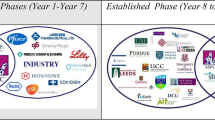Abstract
Focusing on the management of voluntary and involuntary transfers of know-how in imperfect competition, the Industrial Organisation models on R&D cooperation have generated results that seem to be robust across a wide variety of models. This paper reviews the mainstream IO models and results. A major finding is that when spillovers exceed some critical level, cooperation in R&D is beneficial to technical progress and leads to higher profits for the partners. Trying to further enrich these models, recent theoretical developments have studied the issues of stability of R&D cooperation, explaining why attractive alliances are not always formed. The various mechanisms, which this literature suggests to turn R&D cooperation into stable profitable agreements, are discussed. Finally, the scarce empirical evidence that exists to test some of the theoretical hypotheses is reviewed.
Similar content being viewed by others
REFERENCES
Aghion, P. and J. Tirole (1994), ‘The Management of an Innovation', Quarterly Journal of Economics, 109, pp. 1185–1209.
d' Aspremont, C., A. Jacquemin, J. Gabszewicz, and J. Weymark (1983), ‘On the Stability of Collusive Price Leadership', Canadian Journal of Economics, 16, pp. 7–25.
d'Aspremont, C. and A. Jacquemin (1988), ‘Cooperative and Non-cooperative R&D in Duopoly with Spillovers', American Economic Review, 78, pp. 1133–1137.
Baumol, W. (1993), ‘Entrepreneurship, Management, and the Structure of Payoffs', MIT press.
Beath, J., Y. Katsoulacos, and D. Ulph (1988), ‘R&D Rivalry versus R& Cooperation under Uncertainty', Recherches Economiques de Louvain, 54, pp. 373–384.
Beath, J., Y. Katsoulacos and D. Ulph (1989), ‘The Game-Theoretic Analysis of Innovation: a Survey', Bulletin of Economic Research, 41, pp. 163–184.
Berg, S., J. Duncan, and P. Friedman (1982), ‘Joint Venture Strategies and Corporate Innovation', Cambridge, MA.
Bernstein, J. (1988), ‘Cost of Production, Intra and Inter-industry R&D Spillovers: Canadian Evidence', Canadian Journal of Economics, 2, pp. 324–347.
Bernstein, J. and M. Nadiri (1989), ‘R& and Intra-industry Spillovers: an Empirical Application of Dynamic Duality', Review of Economic Studies, 56, pp. 249–269.
Bhattacharya, S., J. Glazer and Sappington (1992), ‘Licensing and the Sharing of Knowledge in Research Joint Ventures', Journal of Economic Theory, 56, pp. 43–69.
Bloch, F. (1995), ‘Endogeneous Structures of Associations in Oligopolies', Rand Journal of Economics, 26, pp. 537–555.
Bondt, R. de, P. Slaets and B. Cassiman (1992), ‘Spillovers and the Number of Rivals for Maximum Effective R&D', International Journal of Industrial Organisation, 10, 35–54.
Bondt, R. de and C. Wu (1997), ‘Research Joint Venture Cartels and Welfare', in: J. Poyago-Theotoky ed. R&D Cooperation: Theory and Practice, Macmillan, London, pp. 39–56.
Bondt, R. de and I. Henriques (1995), ‘Strategic-Investment with Asymmetric Spillovers', Canadian Journal of Economics, 28, pp. 656–674.
Bondt, R. de (1996), ‘Spillovers and Innovative Activities’, International Journal of Industrial Organisation, 15, pp. 1–28.
Bondt, R. de and R. Veugelers (1991), ‘Strategic Investment with Spillovers’, European Journal of Political Economy, 7, pp. 345–366.
Brander, J. and B. Spencer (1984), ‘Strategic Commitment with R0026;D: the Symmetric Case’, Bell Journal of Economics, 14, pp. 225–235.
Cainarca, G., M. Colombo, S. Mariotti, C. Ciborra, G. De Michelis, and M. Losano (1989), ‘Tecnologie dell'informazionee accordi traimprese’, Fonzaioine Olivetti, Edisione di Comunita. 1989.
Colombo, M. and P. Gerrone (1996), ‘Technological Cooperative Agreements and Firm's R& Intensity’, Research Policy, 25, pp. 923–932.
Chaudhuri, P. (1995), ‘Technological Asymmetry and Joint Product Development’, International Journal of Industrial Organisation, 13, pp. 23–39.
Choi, J.P. (1993), ‘Cooperative R&D with Product Market Competition’, International Journal of Industrial Organisation, 11, pp. 553–570.
Cohen, W. and D. Levintahl (1989), ‘Innovation and Learning: the Two Faces of R&D’, Economic Journal, 99, pp. 569–596.
Author information
Authors and Affiliations
Rights and permissions
About this article
Cite this article
Veugelers, R. Collaboration in R&D: An Assessment of Theoretical and Empirical Findings. De Economist 146, 419–443 (1998). https://doi.org/10.1023/A:1003243727470
Issue Date:
DOI: https://doi.org/10.1023/A:1003243727470




